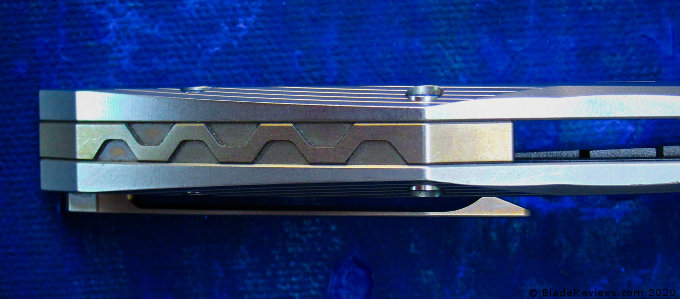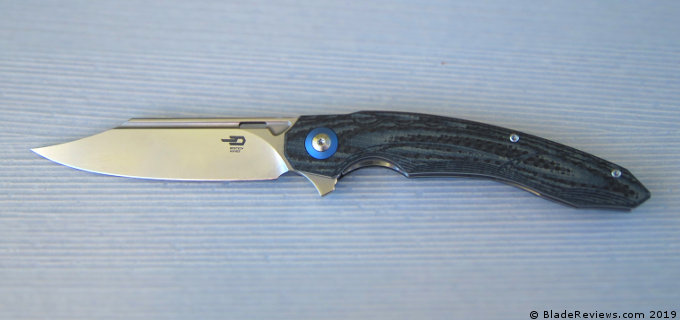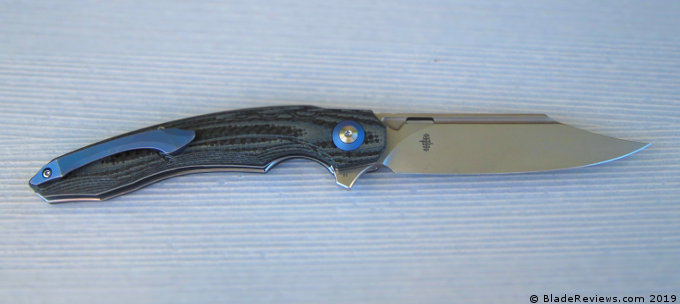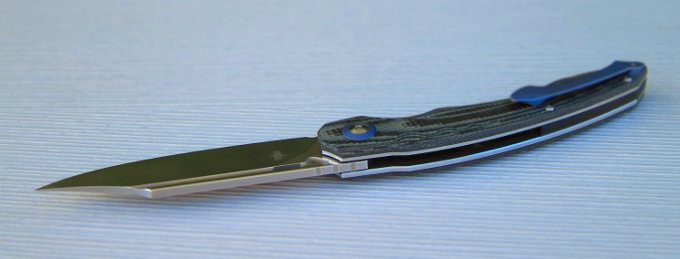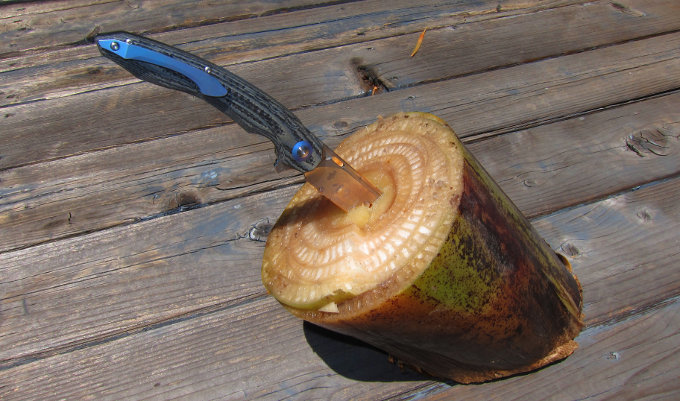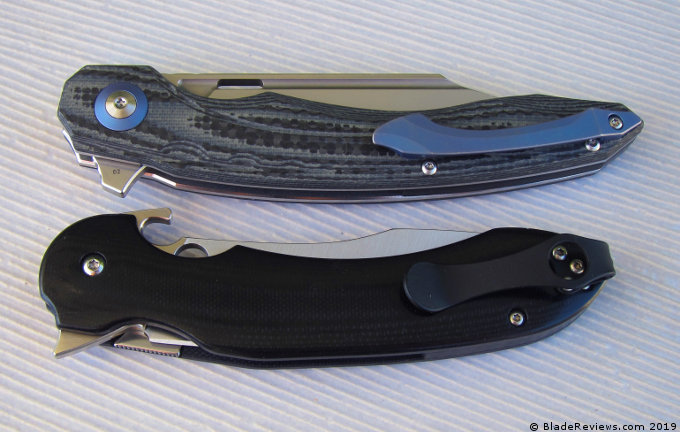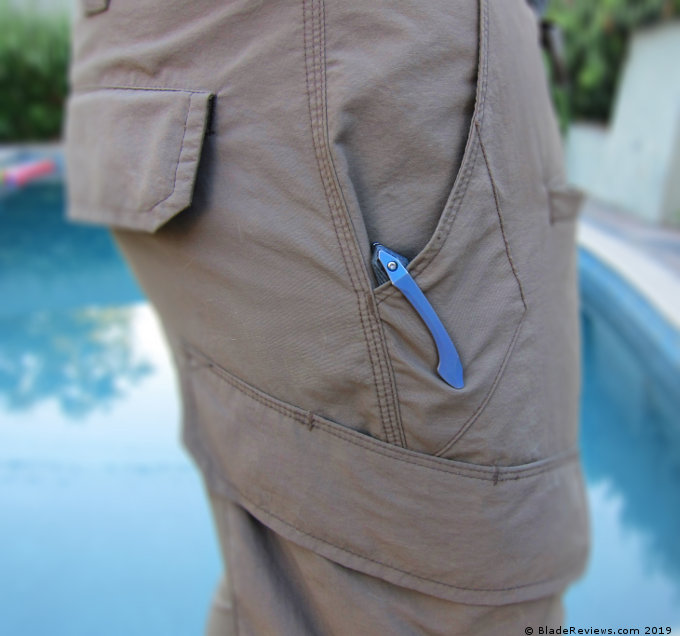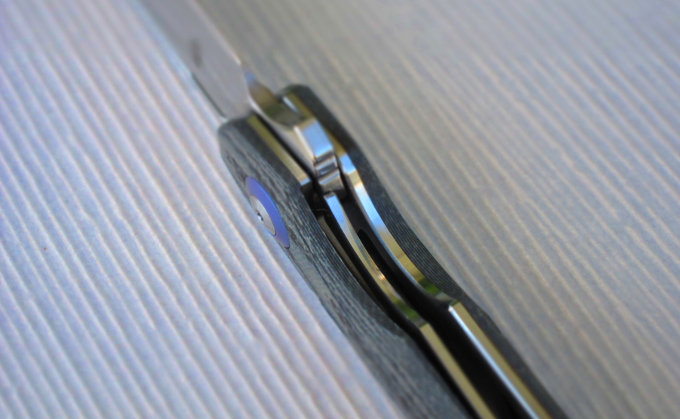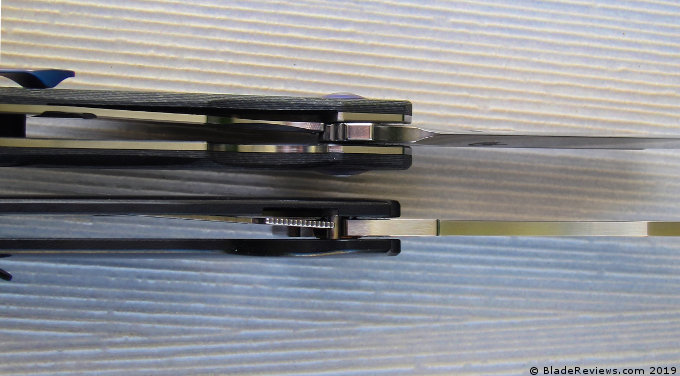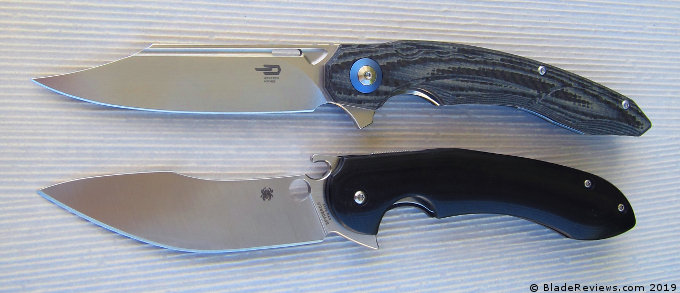Kombou is on fire lately! In the last few years, Bestech Knives has released 8 knives that he’s designed, including the Marukka reviewed here. I bought the Marukka the day it was released, and as I write this review 60 days later, two more Bestech/Kombou knives are starting to hit stores: the Wibra and the Irida.
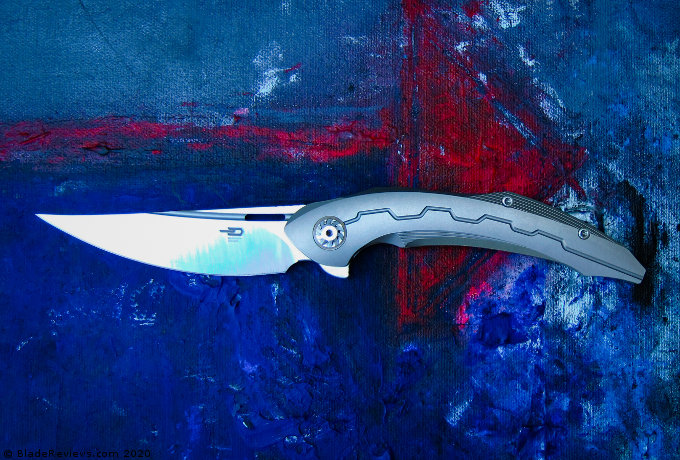
Buy the Bestech Marukka at BladeHQ
No products found.
Kombou is the nom de couteau of Grzegorz Grabarski of Siedlce, Poland. I’m the kind of guy that notices and appreciates the evolution of an artist’s work, and I’ve been keeping an eye on Kombou for a couple of years now. I reviewed his Bestech Knives Fanga knife (see pic below) here on Blade Reviews in August 2019, and I found it be be a great knife and a good value for the money.
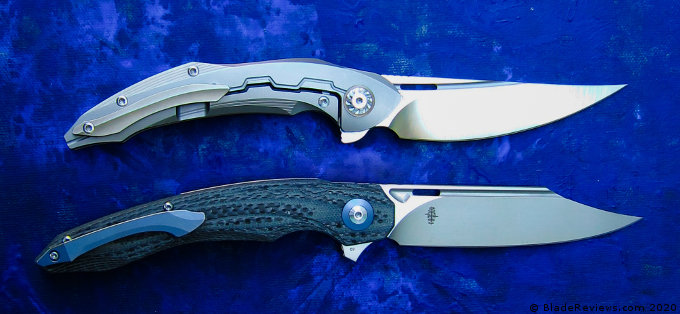
I’ve been stalking the Marukka on Instagram since I first saw it teased by Kombou in June of 2019. When it was finally released in April 2020, it easily passed all my stringent knife buying requirements:
- Is it made of quality materials? Yes, titanium and M390 steel.
- Is it reasonably priced for what it is? Yes, $272.
- Is it like a big bio-mechanical stabbing machine? Yes!
I’ve been carrying the Bestech Marukka for the last 60 days. Here’s what I’ve discovered:
General Dimensions and Blade Details
The handle is 5” (127 mm), and when opened, the blade adds another 3.75” (95 mm) for an impressive overall length of 8.75” (203 mm). It’s tough to tell from the pictures, but this is a pretty big knife.
The blade steel is Bohler M390, which is an excellent powder metallurgy “super steel” with above average toughness (basically the ability to bend instead of breaking) and extremely high hardness (basically the ability to hold an edge.) M390’s bias of hardness over toughness is great for people like me who don’t sharpen their knives regularly. M390 steel or its contemporaries (like Crucible 20CV, Carpenter 204P, or Uddeholm Elmax) are generally expected in a premium production knife like the Marukka, and I’ve yet to be disappointed with the edge-holding performance any of those steels.
The blade has a substantial spine, starting out at 3.85 mm thick, but tapering to a quite thin .45 mm near the blade’s tip. The design of the Marukka’s blade appears to be simple, but there are a lot of subtle details I really like. It’s a Persian style blade, and the spine has a slight downward recurve before rising to the tip.
There’s a decorative fuller that looks straight but actually shares the slight recurve of the spine. The ricasso (the unsharpened portion of the blade between the handle and the primary sharpening bevel) is stonewashed, but the rest of the blade has a shinier satin finish, which is a cool touch in my opinion. It’s also quite difficult to show in a photograph, since it’s mainly just a difference in reflectivity.
The titanium pocket clip, pivot collar, and backspacer are anodized a brass-y/champagne-y color, and they were also hard for me to due justice to in pictures because the color is pretty subtle. There are currently two other color variants of the Marukka available, both with black stonewashed blades, but they don’t have the dual-finish blade treatment.
I’m kookoo for stabby-looking knives, but I’m also well aware of their limited usefulness in my life. My favorite knife of all time is my Microtech Ultratech signature version with a copper handle.
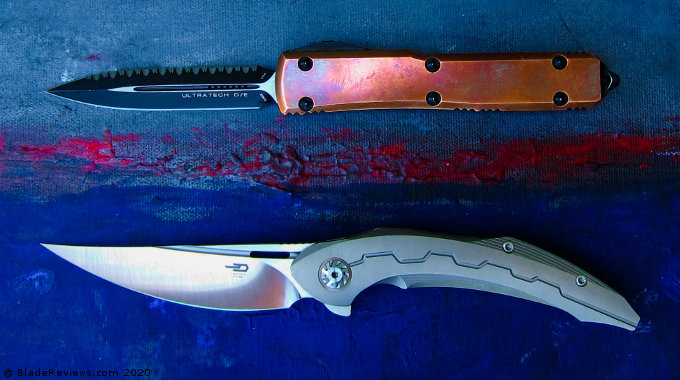
I don’t know what specific use the Ultratech was originally designed for, but I’m guessing it was murder. Mine even happens to be serial number 187, which is police code for… murder! I mainly use mine to murder boxes and loose threads on my clothes. The Ultatech’s blade is so thin and pointy that I can’t use it to scrape or pry anything for fear of snapping off the tip. I’m sure If I ever tried to clean under my fingernails with it, I’d be typing this with only nine fingers. Furthermore, its copper handle is so heavy that grabbing the tip of the blade between thumb and fingers to do detail work is like trying to tap in a nail with the handle of a hammer- the heavy head is at the far end, throwing off your balance. So I obviously don’t care about logic (or California switchblade knife laws), and love my impractical, stabby Ultratech.
The Marukka is far more practical and well-balanced. Its thin blade slices fruit and vegetables really well for a folding knife, and the combination of the blade’s low belly and the handle’s high arch let me dice onions without rapping my knuckles on the cutting board with every chop. It’s no kitchen knife, but it’ll do nicely in a pinch. Speaking of alternate knife uses, I always open my mail with the unsharpened spine of whatever knife is in my pocket- unless it’s the Marukka. The tip of this thing is so thin and sharp that I just know I’m going to end up slicing open my hand along with my electric bill. For me it’s usually “Oh shit, did I cut myself? There’s no blood- oh there it comes, so much blood!!!”
Placing my irrational fear aside for a moment, I think if I were to use this knife as hard as I’ve used my DPX Gear HEST/F or my Chris Reeve Knives Sebenza, then I would be a little worried about snapping off the Marukka’s tip.
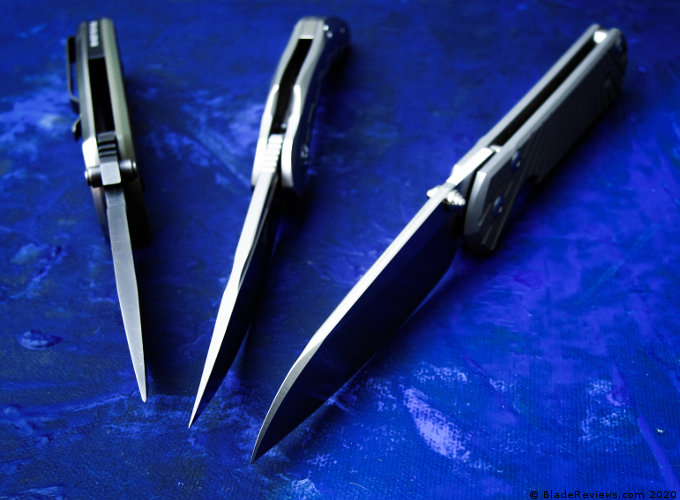
The HEST/F knife (above, left) has a tip that’s protected against snapping off due to its absurdly thick blade stock, and the Sebenza’s tip is thin but is protected by geometry. My Sebenza (above, right) has the Insingo blade option, which is a sheepsfoot style blade. One of the reasons I like sheepsfoot blades is that their spines abruptly plummet down to the tip, resulting in a little more thick steel near the tip compared to the Marukka’s Persian style blade.
Handle, Ergonomics, and Pocket Clip

To test my weak tip assumption, I attacked a huge stack of industrial-sized extra thick cardboard boxes held together with large copper staples. After ten minutes of hacking them into recycling bin size (and running the blade right over the staples) I can say that the handle is comfortable and I didn’t worry once about breaking the Marukka’s tip. The balance point of this surprisingly light knife (4.02 oz / 114.4 g) is just behind the index finger groove in the handle, and it was easy to manipulate with and without gloves. The milled pocket clip added to my grip retention.
I’ve found that pocket clips often create hot spots and interfere with either a standard or overhanded grip. In fact, the DPX HEST/F (the green handled knife from a couple of pictures ago) has perhaps my least ergonomically-friendly clip of anything I own. But the Marukka’s clip is rounded and contoured, and pushed my ring and pinky fingers into an ideal grip when flipping it open. It’s obvious to me that Kombou didn’t just put the clip on as an afterthought, but thoroughly integrated it into the design.
In my months of everyday carry, the Marukka never accidentally slipped out of my pocket, but it would ride up to the tip of the clip if I’d been lying down with it clipped to my pocket. That also happens with almost every other single knife I own except my precious Microtech Ultratech, which has a “double dip” clip that keeps it snug in the bottom of my pocket.
The handle of the Marukka has 4” (102 mm) of usable gripping space, which allows me a full four finger grip with room to spare. Visually, it’s a mixture of organic curves and machine-like lines and angles. It’s like a dagger made from the Terminator’s wrist bone. The word that leaps out at me is bio-mechanical, probably because I just finished reading all five books in the “Murderbot Diaries” series of science fiction novels by Martha Wells. The main character (who calls itself Murderbot) is a human/robot hybrid, and I imagine Murderbot would appreciate the Marukka’s design aesthetic, even though it wouldn’t admit that to a human. The books are super fun, have great action interspersed with dry humor, and have won just about every sci-fi award available, including the Hugo, Nebula, Alex, and Locus Awards. Sorry- I know this is a knife review, not a book review, so back to the knife.
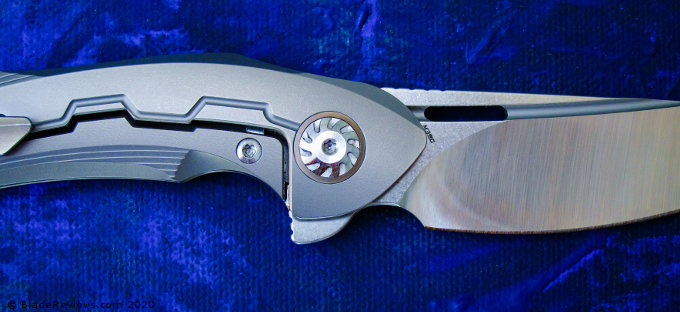
There are several mechanical-style details on the Marukka’s handle. The pivot screw, for example, has the look of a spinning turbine, and the machined line that travels from the pivot screw to the end of the handle looks to me like either a gear or a circuit board. The cut on the lock side that forms the framelock follows that crenelated line to some extent. That’s pretty unique, since the framelock cut is more or less a straight line on about 90% of framelock knives ever since Chris Reeve invented the framelock in the late 1980’s.
The “bio” part of the bio-mechanical theme is most evident in the shape and angles of the handle, particularly on the top of the spine.
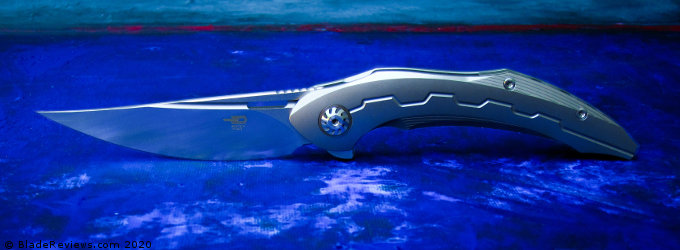
There’s a little flat-ish area where the handle meets the blade, which is obviously designed as a comfortable thumb shelf when holding the knife in a regular grip. Behind that is another swoopy indentation, which, along with the thin milled stripes behind it, is purely decorative as far as I can tell. In matters of design, I’m a huge fan of unexpected lines and angles, and Kombou could have just kept the spine going in one long curving line like he did in the Bestech Fanga (2nd picture from the top of the article) but instead he gave us an organic, multi-angled flourish. It’s clear to me that his design style is evolving, and I enjoy noticing the steps he takes along the way.
Deployment and Lockup
The Marukka is a flipper-opening framelock, and the action is light and snappy. The blade pivots on ceramic ball bearings, and the titanium framelock has a steel insert where it meets the blade.

This theoretically replaceable insert prevents titanium on steel friction, which can sometimes result in the knife getting stuck open. This used to happen with my previously mentioned DPX Gear HEST/F, which did not have a steel lockbar insert. I realize that I’ve used it as a bad example twice now, but the HEST/F was quite technologically advanced in 2012 when I bought it- which goes to show how rapidly the knife world has advanced in the last decade.
The detent of a flipper knife controls how much force must be applied to the flipper tab to snap the blade out of its closed position. A weak detent may result in the blade not fully opening, and a detent that’s too strong just kinda sucks. The Marukka’s detent is perfect, as is the detent on the two other Bestech Knives I own. The lockup is solid and there’s no blade play either opened or closed. Actually, I can’t even think of a single modern framelock knife I’ve handled that has any blade play… well, except for my HEST/F (oh no- not again! Sorry DPX Gear!) but its blade wiggle is the direct result of it being my favorite beater knife for almost a decade.
Bestech Marukka Review – Final Thoughts
I pay a lot of attention to details, and I had to dig deep into the details to find anything negative to say about the Marukka. This is all I could come up with: the steel lockbar insert is pretty sharp, and can scratch my thumb if I hold it too far forward when closing the blade. That’s it- I have no other complaints. It’s not cheap, but neither is the the unique and precise machining that went into this big, futuristic-looking, bio-mechanical stabbing machine. Like Martha Wells’ Murderbot, the Marukka is fascinating and dangerous, but smooth around the edges. I recommend it.
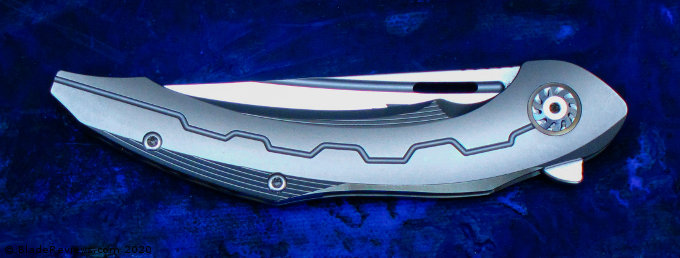
Thank you to Sara O’Neil for the use of her painting.
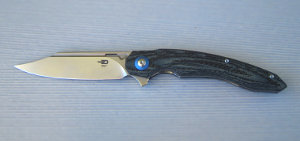
Bestech Marukka – From $272.00
From: BladeHQ
No products found.
Editor: I recommend purchasing the Bestech Marukka at BladeHQ and Amazon. Thank you very much.
